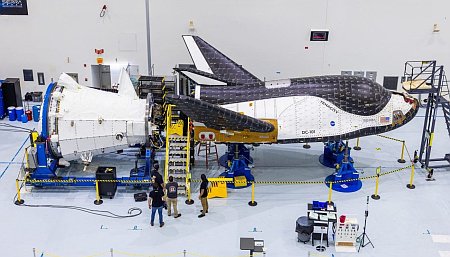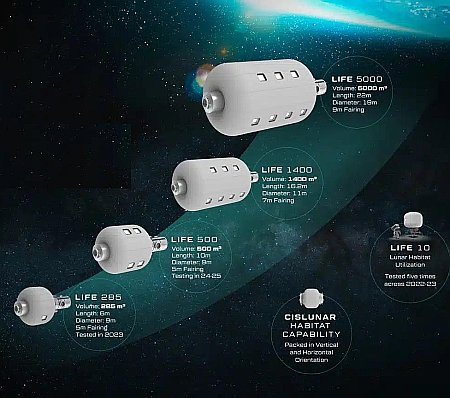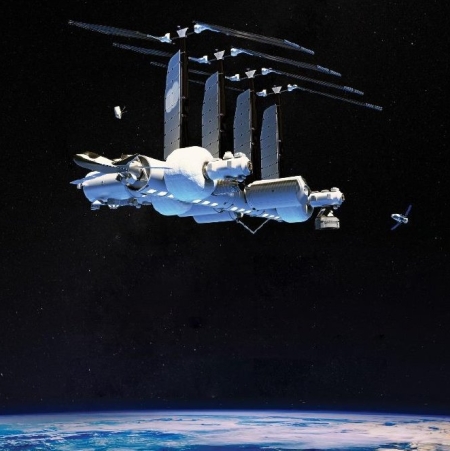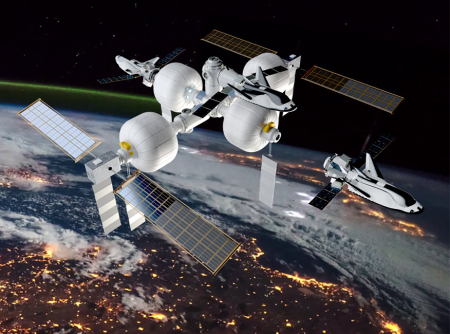Sierra Space finally completes preflight tests of its Tenacity Dream Chaser mini-shuttle
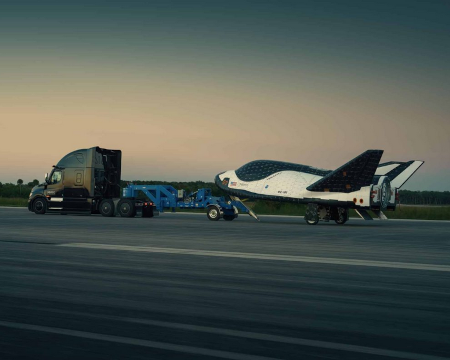
Tenacity undergoing recent tow tests.
Click for original image.
Sierra Space today announced that has finally completed the preflight ground tests of its Tenacity Dream Chaser mini-shuttle required prior to launch.
As part of its comprehensive testing campaign, Dream Chaser underwent Electromagnetic Interference and Electromagnetic Compatibility (EMI/EMC) testing at NASA’s Space Systems Processing Facility (SSPF). These tests verified the spacecraft’s ability to operate within expected electromagnetic environments throughout various missions.
The spacecraft also completed rigorous tow testing at KSC and Space Florida’s Launch and Landing Facility. For this phase, a Freightliner Cascadia truck, provided by Daimler Truck North America, towed the spaceplane at high speeds to simulate critical dynamics and validating autonomous navigational parameters during runway landing operations.
Additionally, Dream Chaser successfully demonstrated the ability to receive telemetry and distribute commands between the spacecraft and Mission Control in Louisville, Colorado over NASA’s Tracking and Data Relay Satellite System network. This key milestone tested the spacecraft’s readiness for real-time command and control during flight operations.
The testing campaign concluded with a post landing recovery rehearsal, which demonstrated the safing of vehicle systems and timely access to sensitive payloads. [emphasis mine]
The electromagnetic and telemetry began more than two years ago — along with standard vibration test — and under normal conditions should have been completed in only a few months. In fact, when that testing began the company expected to launch Tenacity to ISS on a Vulcan rocket sometime in 2024. While the vibration tests completed as expected, the other tests did not. Instead, we waited, and waited, and waited, with no word on the results, suggesting strongly that something had been found that made that launch impossible without significant changes.
The description of the tow tests that I highlighted above add further weight to this speculation. Such tow tests should have been done long before those final electromagnetic, telemetry, and vibration tests. To have to do such tow tests now suggests strongly that those ground tests found something wrong that required changes and further tow tests.
Though NASA has canceled its ISS cargo contract with Sierra using Tenacity, the company says it still plans to launch the mini-shuttle on an orbital demonstration mission late in 2026, with it landing back on a runway at Vandenberg Space Force Base in California.
Don’t put much money on this. This mini-shuttle was first proposed in 2014, and has been repeatedly delayed over and over again. It remains unclear whether it will ever launch.

Tenacity undergoing recent tow tests.
Click for original image.
Sierra Space today announced that has finally completed the preflight ground tests of its Tenacity Dream Chaser mini-shuttle required prior to launch.
As part of its comprehensive testing campaign, Dream Chaser underwent Electromagnetic Interference and Electromagnetic Compatibility (EMI/EMC) testing at NASA’s Space Systems Processing Facility (SSPF). These tests verified the spacecraft’s ability to operate within expected electromagnetic environments throughout various missions.
The spacecraft also completed rigorous tow testing at KSC and Space Florida’s Launch and Landing Facility. For this phase, a Freightliner Cascadia truck, provided by Daimler Truck North America, towed the spaceplane at high speeds to simulate critical dynamics and validating autonomous navigational parameters during runway landing operations.
Additionally, Dream Chaser successfully demonstrated the ability to receive telemetry and distribute commands between the spacecraft and Mission Control in Louisville, Colorado over NASA’s Tracking and Data Relay Satellite System network. This key milestone tested the spacecraft’s readiness for real-time command and control during flight operations.
The testing campaign concluded with a post landing recovery rehearsal, which demonstrated the safing of vehicle systems and timely access to sensitive payloads. [emphasis mine]
The electromagnetic and telemetry began more than two years ago — along with standard vibration test — and under normal conditions should have been completed in only a few months. In fact, when that testing began the company expected to launch Tenacity to ISS on a Vulcan rocket sometime in 2024. While the vibration tests completed as expected, the other tests did not. Instead, we waited, and waited, and waited, with no word on the results, suggesting strongly that something had been found that made that launch impossible without significant changes.
The description of the tow tests that I highlighted above add further weight to this speculation. Such tow tests should have been done long before those final electromagnetic, telemetry, and vibration tests. To have to do such tow tests now suggests strongly that those ground tests found something wrong that required changes and further tow tests.
Though NASA has canceled its ISS cargo contract with Sierra using Tenacity, the company says it still plans to launch the mini-shuttle on an orbital demonstration mission late in 2026, with it landing back on a runway at Vandenberg Space Force Base in California.
Don’t put much money on this. This mini-shuttle was first proposed in 2014, and has been repeatedly delayed over and over again. It remains unclear whether it will ever launch.

